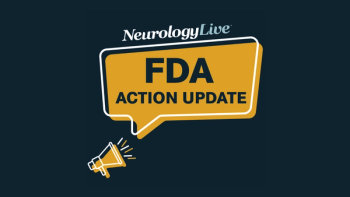
NDA for Qtrypta Accepted for Acute Migraine
The drug’s Prescription Drug User Fee Act date is set for October 20, 2020.
Steven Lo
The FDA has accepted a new drug application (NDA) for Zosano Pharma’s Qtrypta for the acute treatment of
Qtrypta is a proprietary formulation of zolmitriptan that is delivered using the company’s ADAM (Adhesive Dermally Applied Microarray) intracutaneous microneedle system, which penetrates the epidermis and dermis and delivers the drug quickly into the bloodstream.
“I believe Qtrypta, if approved, will offer patients with difficult to treat migraine attacks a new, non-oral treatment option that gives them confidence and control over their attacks and ability to get back to life,” Alan M. Rapoport, MD, clinical professor of neurology at the David Geffen School of Medicine at UCLA, said in a statement.1
The FDA’s decision was based off results from the double-blind, placebo-controlled, parallel-group, multicenter phase 2/3 ZOTRIP clinical study (NCT02745392), which assessed the efficacy, safety, and tolerability of Qtrypta in 1 mg, 1.9 mg, and 3.8 mg doses versus placebo. Researchers used pain freedom and relief of the most bothersome symptoms at 2 hours postdose as the co-primary end points of the study.2
At 2 hours postdose, 41.5% of patients in the Qtrypta 3.8 mg group were pain-free compared to 14.2% of those on placebo at 2 hours (OR 5.11; 95% CI, 1.96—13.30; P = .0001). Additionally, 68.3% who received Qtrypta 3.8 mg were free of their most bothersome symptom at 2 hours postdose compared with 42.9% of patients on placebo (OR 2.86; 95% CI, 1.28—6.43; P = .0009).
READ MORE:
The investigators also reported that more patients who received Qtrypta 3.8 mg were free of photophobia, phonophobia, and nausea2 hours postdose compared with placebo. The proportion of patients who reported pain relief up to 48 hours postdose was also greater among those who took Qtrypta 3.8 mg.2
Additional data from a post-hoc analysis published in Headache: The Journal of Head and Face Pain in January 20193 showed that in patients with severe pain, pain freedom and freedom from most bothersome symptom at 2 hours postdose was reported by 26% and 64% of patients in the treatment group compared with 15% and 42% of the placebo group, respectively.
Redness at the application site was among the top reported adverse events reported in the phase 3 long term safety study. Overall, 95% of the reported adverse events were mild in nature, with 80% of them resolved within 24 hours. Triptan-like neurological side effects, such as dizziness and paresthesia, were reported in less than 2% of patients.
“The FDA’s filing of our NDA represents a significant milestone and an important step for Zosano and Qtrypta toward our goal of bringing an innovative therapy that we believe can make an important difference in the lives of patients who suffer from migraine,” Steven Lo, president and chief executive officer of Zosano, said in a statement.1 “We believe Qtrypta, if approved, has the potential to offer patients rapid, sustained pain relief with no recurrence.”
REFERENCES:
1. Zosano Pharma announces FDA acceptance of 505 (b)(2) new drug application for Qtrypta for the acute treatment of migraine [news release]. Fremont, CA. Zosano. March 4, 2020. Accessed March 4, 2020. finance.yahoo.com/news/zosano-pharma-announces-fda-acceptance-130010898.html
2. Spierings EL, Brandes JL, Kudrow DB, et al. Randomized, double-blind, placebo-controlled, parallel-group, multi-center study of the safety and efficacy of ADAM zolmitriptan for the acute treatment of migraine. Cephalalgia. 2018;38(2):215-224. doi: 10.1177/0333102417737765
3. Tepper TJ, Dodick DW, Schmidt PC, Kellerman DJ. Efficacy of ADAM zolmitriptan for the acute treatment of difficult-to-treat migraine headaches. Headache. 2019 Apr;59(4):509-517. doi: 10.1111/head.13482
Newsletter
Keep your finger on the pulse of neurology—subscribe to NeurologyLive for expert interviews, new data, and breakthrough treatment updates.




























